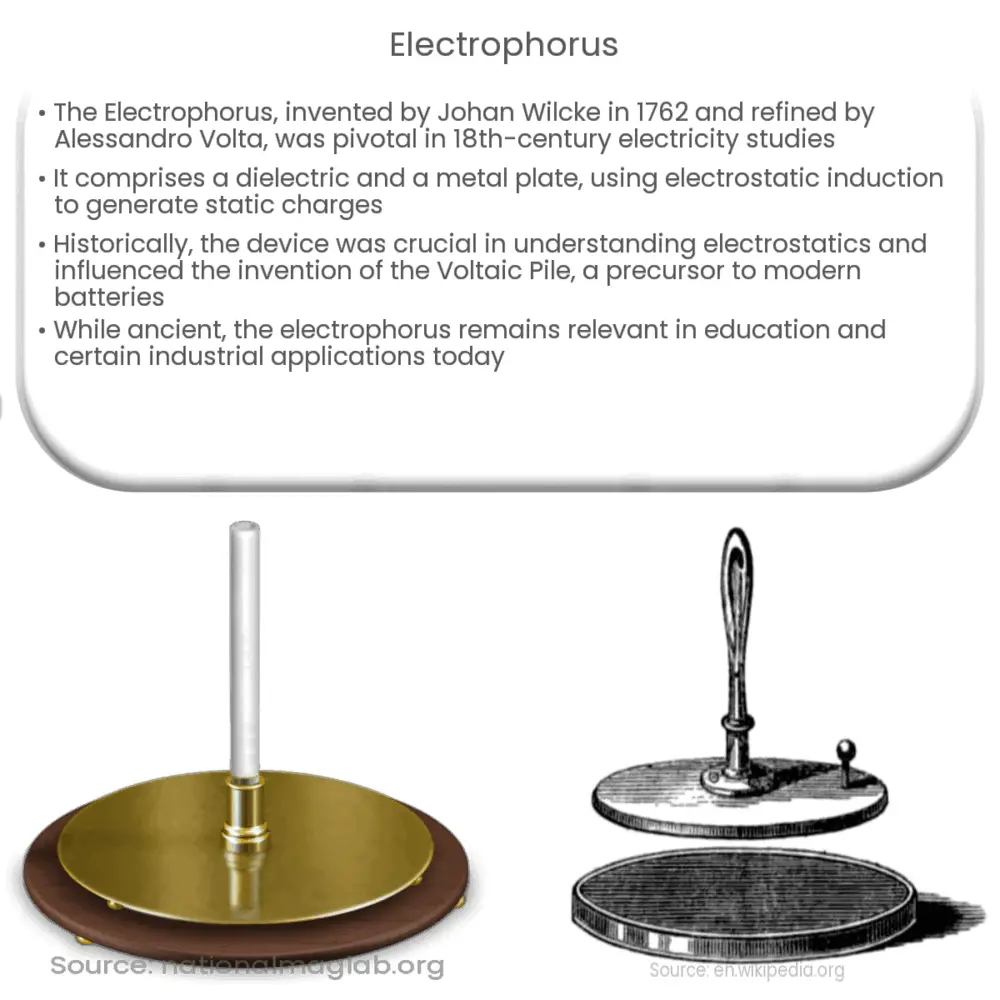Explore the history, design, and importance of the Electrophorus, a pivotal tool in understanding electricity and electrostatics.

Introduction to Electrophorus
The Electrophorus is a remarkable apparatus that stands as a historical cornerstone in the exploration of electricity. Invented by the German scientist Johan Wilcke in 1762, the device was later improved by the renowned Italian physicist Alessandro Volta. The term ‘Electrophorus’ is derived from Greek words ‘electron’, meaning amber, and ‘pherein’, meaning to bear or carry. It is literally an ‘electricity carrier’. Its purpose was to generate a static electric charge, a pivotal tool in the realm of 18th-century scientific experiments.
Design and Principle of Operation
An electrophorus comprises two primary components: a dielectric (non-conducting substance) and a metal plate with an insulating handle. The dielectric, often made from materials such as resin, sulfur, or glass, is the part that gets charged through a process called ‘influence’.
- Charging the Dielectric: The dielectric is initially charged through friction, which involves rubbing it with a suitable material. For instance, rubbing a resin plate with wool.
- Influence and Induction: The metal plate, when brought close to but not touching the charged dielectric, experiences a phenomenon known as electrostatic induction. This causes a redistribution of electric charges within the plate. The side closer to the dielectric becomes oppositely charged, while the other side acquires a charge identical to the dielectric.
- Grounding: By touching the metal plate’s handle (usually with a finger), the charge identical to the dielectric can move to the ground, leaving the plate with an opposite charge.
This process can be repeated multiple times, generating a larger static charge each time. An important point to note is that the charge on the dielectric does not deplete significantly during this process, thanks to the principle of electrostatic induction, enabling the electrophorus to be used repeatedly without recharging.
Applications and Importance in History
In the realm of historical physics, the electrophorus had a significant impact. This simple device facilitated the study and understanding of electrostatics, a fundamental aspect of physics. Its simplicity and efficiency made it a commonly used instrument in laboratories and educational institutions during the 18th and 19th centuries.
The electrophorus also had a crucial role in the invention of the Voltaic Pile by Alessandro Volta, which marked the advent of the modern battery. It demonstrated that electricity could be generated chemically, setting the groundwork for the electrochemical cells we use today.
The Electrophorus in the Modern World
Despite being a centuries-old invention, the electrophorus still finds usage in the modern world, particularly in the field of education. Its ability to generate and demonstrate static electricity in a simple, safe, and cost-effective manner makes it an ideal teaching tool in physics classes. Students can easily construct an electrophorus to understand the principles of electrostatics and induction, bridging the gap between theoretical knowledge and practical understanding.
Besides educational applications, an electrophorus can also be used to ignite a combustible mixture, thereby finding its usage in certain industrial applications. For instance, it can initiate combustion in certain types of internal combustion engines or in scientific laboratories for experimental purposes.
Influence on Future Inventions
It is undeniable that the electrophorus set the groundwork for numerous modern technological advancements. As mentioned earlier, Volta’s work with the electrophorus eventually led him to invent the voltaic pile, the first true battery. This invention revolutionized the world of energy storage and electrical power, enabling countless subsequent innovations in diverse fields, from telecommunications to electric vehicles.
Conclusion
In conclusion, the Electrophorus is a powerful tool that bridged the gap between the mystical understanding of electricity and the systematic scientific comprehension we now have. Its simple design, allied with its remarkable ability to demonstrate key principles of electrostatics, has earned it an irreplaceable spot in the annals of scientific history. Even in the present day, the electrophorus continues to serve as an essential learning tool, illustrating the basic principles of electricity to new generations of curious minds. Through the lens of this historical device, we see the journey of human knowledge from a rudimentary understanding of the electric charge to the complex and intricate technologies that now define our modern world.

